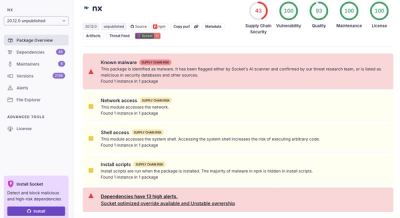
Security News
Risky Biz Podcast: Making Reachability Analysis Work in Real-World Codebases
This episode explores the hard problem of reachability analysis, from static analysis limits to handling dynamic languages and massive dependency trees.
@anatolyk/react-native-week-view
Advanced tools

import WeekView from 'react-native-week-view';
const myEvents = [
{
id: 1,
description: 'Event',
startDate: new Date(2021, 3, 15, 12, 0),
endDate: new Date(2021, 3, 15, 12, 30),
color: 'blue',
// ... more properties if needed,
},
// More events...
];
const MyComponent = () => (
<WeekView
events={myEvents}
selectedDate={new Date(2021, 3, 15)}
numberOfDays={7}
/>
);
events (Array) - Events to display, in Event Object format (see sub-section below)onEventPress (Function) - Callback when event item is pressed, receives the event-object: (event) => {}.onEventLongPress (Function) - Callback when event item is long pressed, same signature as onEventPress.numberOfDays (Number) - Set number of days to show in view, can be 1, 3, 5, 7.weekStartsOn (Number) - Day to start the week (0 is Sunday, 1 is Monday, and so on). Defaults to 1. Only useful when numberOfDays === 7 or fixedHorizontally is true.formatDateHeader (String) - Format for dates of header, default is MMM DselectedDate (Date) - Intial date to show week/days in the view. Note: changing this prop will not have any effect in the displayed date; to actually change the date being displayed, use the goToDate() method, see below.onSwipeNext (Function) - Callback when calendar is swiped to next week/daysonSwipePrev (Function) - Callback when calendar is swiped to previous week/dayslocale (String) - locale for the header, there's a addLocale function to add cusomized locale. Default is en.showTitle (Boolean) - show/hide the title (the selected month and year). Default is true.headerStyle (Object) - custom styles for header container. Example: { backgroundColor: '#4286f4', color: '#fff', borderColor: '#fff' }headerTextStyle (Object) - custom styles for text inside header. Includes day names and title (month)hourTextStyle (Object) - custom styles for text displaying hours in the left.eventContainerStyle (Object) - custom styles for the event container. Notice the background color and positioning (absolute) are already set.hoursInDisplay (Number) - Amount of hours to display in the screen. Default is 6.timeStep (Number) - Number of minutes to use as step in the time labels shown in the left. Default is 60 (1 hour).formatTimeLabel (String) - Formatter for the time labels shown in the left. Defaults to "H:mm" (e.g. 16:00, 16:30, etc). To use AM/PM formatting, set to "h:mm A" (e.g. 4:00 PM, 4:30 PM, etc), or "h:mm a" for lowercase. See docs on momentjs for all available formatters.startHour (Number) - Hour to scroll to on start. Default is 8 (8 am).onGridClick (Function) - Callback when the grid view is clicked, signature: (pressEvent, startHour, date) => {}.
pressEvent (Object) - object passed by the TouchableWithoutFeedback.onPress() method (and not an event object as defined below)startHour (Number) - hour clicked (as integer)date (Date) - date object indicating day clicked (the hour is not relevant)onGridLongPress (Function) - Callback when the grid view is long-pressed. Same signature as onGridClickEventComponent (React.Component) - Custom component rendered inside an event. By default, is a Text with the event.description. See sub-section below for details on the component.TodayHeaderComponent (React.Component) - Custom component to highlight today in the header (by default, today looks the same than every day). See details in sub-section belowshowNowLine (Boolean) - If true, displays a line indicating the time right now. Defaults to false.nowLineColor (String) - Color used for the now-line. Defaults to a red #e53935.rightToLeft (Boolean) - If true, render older days to the right and more recent days to the left.fixedHorizontally (Boolean) - If true, the component can be used to display a single fixed week. See example in sub-section below.prependMostRecent (Boolean) - If true, the horizontal prepending is done in the most recent dates. See issue #39 for more details. Default is false.{
id: 1,
description: 'Event',
startDate: new Date(2021, 3, 15, 12, 0),
endDate: new Date(2021, 3, 15, 12, 30),
color: 'blue',
// ... more properties if needed,
}
To use the component methods save a reference to it:
<WeekView
// ... other props
ref={(ref) => { this.weekViewRef = ref; }}
/>
goToDate(date, animated = true): the component navigates to a custom date. Note: if the target date has not been rendered before, there may be a delay on the animation. See this issue for details.goToNextPage(animated = true): the component navigates to the next page (to the future). Note: if prependMostRecent is true, and the component is near the last page rendered, there may be a delay on the animation.goToPrevPage(animated = true): the component navigates to the previous page (to the past). Note: if prependMostRecent is false (the default), and the component is near the first page rendered, there may be a delay on the animation.EventComponentThe custom component will be rendered inside a TouchableOpacity, which has the background color set to event.color, and is placed with absolute position in the grid. The component receives two props:
event (Event) - Event object as described before.position: (Object) - object containing top, left, height and width values in pixels.For example, to display an icon inside each event, such as a react-native-elements Icon:
const MyEventComponent = ({ event, position }) => (
<Icon
name={event.iconName}
type={event.iconType}
color={event.color}
size={position.height}
/>
);
<WeekView
// ... other props
EventComponent={MyEventComponent}
/>
Use this prop to highlight today in the header, by rendering it differently from the other days. The component TodayHeaderComponent receives these props:
date (moment Date) - moment date object containing today's date.formattedDate (String) - day formatted according to formatDateHeader, e.g. "Mon 3".textStyle (Object) - text style used for every day.For example, to highlight today with a bold font:
const MyTodayComponent = ({ formattedDate, textStyle }) => (
<Text style={[textStyle, { fontWeight: 'bold' }]}>{formattedDate}</Text>
);
<WeekView
// ... other props
TodayHeaderComponent={MyTodayComponent}
/>
There's a addLocale function to add customized locale for the component. The component depends on momentjs, you can refer to https://momentjs.com/docs/#/customization/ for more information.
Example:
export WeekView, { addLocale } from 'react-native-week-view';
// add customized localed before using locale prop.
addLocale('fr', {
months: 'janvier_février_mars_avril_mai_juin_juillet_août_septembre_octobre_novembre_décembre'.split('_'),
monthsShort: 'janv._févr._mars_avr._mai_juin_juil._août_sept._oct._nov._déc.'.split('_'),
weekdays: 'dimanche_lundi_mardi_mercredi_jeudi_vendredi_samedi'.split('_'),
weekdaysShort: 'dim._lun._mar._mer._jeu._ven._sam.'.split('_'),
});
The WeekView component can be used to display a fixed week (as a timetable):
Use the prop fixedHorizontally={true}. This prop should not be changed after the first render
To set startDate and endDate in each event, you should use the function provided: createFixedWeekDate(day, hour, minutes=0, seconds=0), where:
day: (Number|String) - specify day of the week as number (1 is monday, 2 is tuesday, etc) or as string (will be parsed with the current locale, e.g. "Monday", "Tuesday", etc. for english).hour: (Number) - specify hour of the day as number (from 0 to 23)minutes: (Number) - specify minutes of the day as number (from 0 to 59), defaults to 0seconds: (Number) - specify seconds of the day as number (from 0 to 59), defaults to 0If you choose to not use createFixedWeekDate(), make sure that startDate and endDate are Date objects within this week, otherwise the events will not be displayed correctly in the timetable.
If the numberOfDays is other than 7, will display the first days of the week. E.g. if numberOfDays === 5, will display from monday to friday.
import WeekView, { createFixedWeekDate } from 'react-native-week-view';
const myEvents = [
{
id: 1,
description: 'Event 1',
startDate: createFixedWeekDate('Monday', 12), // Day may be passed as string
endDate: createFixedWeekDate(1, 14), // Or as number, 1 = monday
color: 'blue',
},
{
id: 2,
description: 'Event 2',
startDate: createFixedWeekDate('wed', 16),
endDate: createFixedWeekDate(3, 16, 30),
color: 'red',
},
];
const MyComponent = () => (
<WeekView
events={myEvents}
fixedHorizontally={true}
// Recommended props:
showTitle={false} // if true, shows this month and year
numberOfDays={7}
formatDateHeader="ddd" // display short name days, e.g. Mon, Tue, etc
// ... other props
/>
);
FAQs
Week View Calendar for React Native
The npm package @anatolyk/react-native-week-view receives a total of 87 weekly downloads. As such, @anatolyk/react-native-week-view popularity was classified as not popular.
We found that @anatolyk/react-native-week-view demonstrated a not healthy version release cadence and project activity because the last version was released a year ago. It has 1 open source maintainer collaborating on the project.
Did you know?

Socket for GitHub automatically highlights issues in each pull request and monitors the health of all your open source dependencies. Discover the contents of your packages and block harmful activity before you install or update your dependencies.

Security News
This episode explores the hard problem of reachability analysis, from static analysis limits to handling dynamic languages and massive dependency trees.

Security News
/Research
Malicious Nx npm versions stole secrets and wallet info using AI CLI tools; Socket’s AI scanner detected the supply chain attack and flagged the malware.

Security News
CISA’s 2025 draft SBOM guidance adds new fields like hashes, licenses, and tool metadata to make software inventories more actionable.